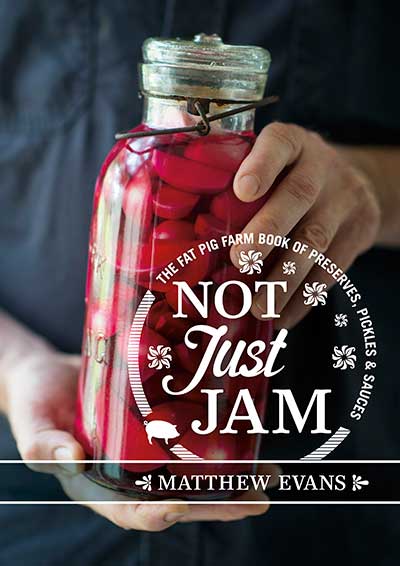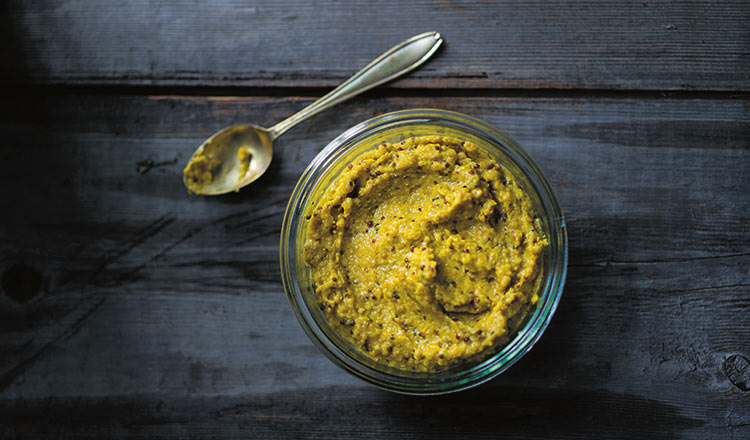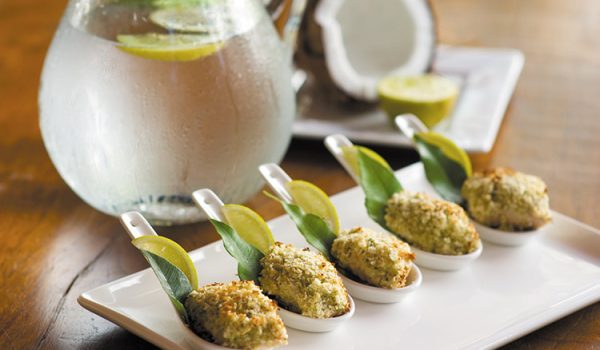This mustard will go tremendously with a bacon sandwich, a roast rib eye of beef, some cheese on toast, or anything else you like mustard with, too.
Makes about 600 g (1 lb / 5 oz)
INGREDIENTS
150 g (5½ oz) yellow mustard seeds
50 g (1¾ oz) brown mustard seeds
1½ teaspoons ground turmeric
330 ml (11¼ fl oz/1 cups) apple cider
100 ml (3½ fl oz) apple cider vinegar
4 garlic cloves, peeled
1 cinnamon stick
1–2 tablespoons honey
METHOD
1 Wash and sterilise* two 300 ml (10½ fl oz) jars.
2 Soak all of the mustard seeds in 250 ml (9 fl oz/1 cup) of water overnight so they soften substantially. Plonk them in a food processor with their soaking juices (most will have been absorbed) and add the turmeric, then blitz well to make a rough paste. Most of the seeds won’t break down so it will never be a smooth mustard, but the more you pulse and grind, the pastier it will become. Add a little of the cider as you go if it is too dry to blend. You can use a mortar for part of the mustard if you like to really grind down the seeds.
3 Heat the remaining apple cider with the vinegar, garlic and cinnamon and boil down to about half the volume. Scoop out the garlic and the cinnamon and add enough of the liquid to the mustard so that it reaches a thick consistency. Stir in the honey, to taste, transfer to sterile jars and store in a cool, dark place such as a pantry for at least a month before using. Once opened, store the mustard in the fridge.
Sterilisation
This is the big one. In the age of refrigeration, we’ve often forgotten how much mould and yeast thrive when left unchecked. You can preserve things through excluding oxygen (tight-fitting lids), introducing an acid (pickled foods), and by adding enough sugar or salt. But even then it’s important to start with really clean implements, and to store things in sterilised jars with sterile lids. So wash your storing jars or containers really well before sterilising.
Try The Heat Method
Heat kills bugs, and bugs can cause your preserves to lose quality, or even go off. If you want to sterilise just one bottle, or a few jars, you can place them in a saucepan of cold water, on their sides, making sure they’re full of water and submerged. Put their lids in there too. Bring this pot to the boil and simmer for 10 minutes. This will kill just about all the bugs you’re worried about. The only downside of this method is that it is a little tricky to take hot bottles from a pot of boiling water, though there are special tongs on the market to help you. A good thing to note is that hot sauces and jams will crack a cold jar, and this method allows you to have your jars prewarmed ready to pour in a hot conserve.
Dishwashers, with a hot rinse cycle, also sterilise the jars, so that could be an easier method.
Be sure, when dealing with hot jars, not to put them onto a cold surface or they will crack. Always put them onto a wooden board. Cold jars will also crack if they have very hot things put in them, so warm the jars a little first, using warm water or similar.
 Recipes and Images from Not Just Jam by Matthew Evans, published by Murdoch Books
Recipes and Images from Not Just Jam by Matthew Evans, published by Murdoch Books









